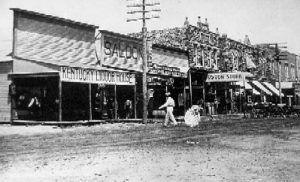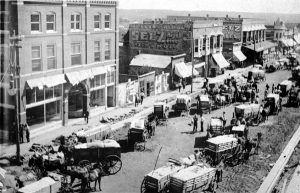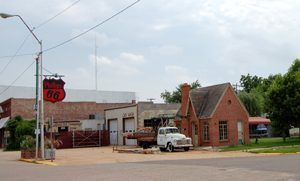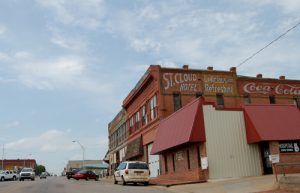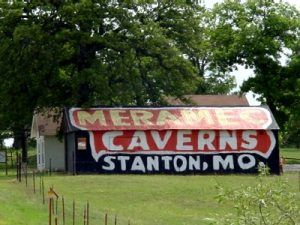Nestled among the rolling hills in the heart of Oklahoma, Chandler was founded after the 1891 Land Rush. On September 22, 1891, almost one million acres of land, formerly owned by the Sac and Fox, Ioway, Potawatomi, and Shawnee Indian tribes, was opened for homesteading. Hundreds of settlers lined the borders of what was then called County A. At a signal given by the military, the pioneers rushed to stake their claims.
The government surveyed the townsite of Chandler and set it aside for public use just six days after the county’s opening. Comprising an area of about one square mile, the up-and-coming town was named in honor of George Chandler, the First Assistant Secretary of the Interior under President Harrison.
The governor appointed the first county officials in October 1891. In its first general election, held on November 8, 1892, the county received an official name—Lincoln—and elected its county officers. Soon, a two-story framed courthouse was built on the town square. The small settlement quickly grew, with several businesses developing along the main street area, including hotels, saloons, stores, and other establishments.
From its beginning until the mid-1920s, cotton production and related activities were the most important sources of income for the citizens of Chandler. At the age of six, children learned to pick cotton, and many continued this throughout their lives. Full attendance at school for older children could not be expected before mid-November, after the entire cotton crop was harvested.
A cottonseed oil factory was located at the end of Allison Avenue and 15th Street. Oil was made from cottonseeds not used for planting the following year’s crop. The cotton oil mill sounded a loud whistle twice a day at the change of the work shifts. The sharp whistle could be heard throughout the town at precisely noon and midnight. For many, it was their only clock.
On March 30, 1897, young Chandler suffered a devastating blow when a tornado completely wiped out the business area and many new homes constructed near it. Within just a few minutes, every building that lay within a four-block-wide area was leveled. Fourteen people were killed and scores of others injured.
Chandler’s other primary source of income was the growing cattle industry, which soon prompted the development of railroads. The Oklahoma City–Sapulpa branch of the Frisco was the first railroad constructed across Lincoln County. These 103 miles of railroad were completed in December 1898. Other railroads were built across parts of the county during 1902, 1903, and 1904, including the Santa Fe, Rock Island, Missouri–Kansas–Texas, and Fort Smith-Western.
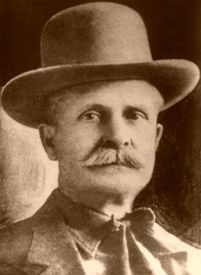
After surviving decades of tough outlaws, Bill Tilghman was shot and killed by a corrupt Prohibition Officer in 1924.
Bill Tilghman, one of the pioneers of the land rush in 1891 and former marshal of Dodge City, was elected sheriff of Lincoln County in 1900. He later served as United States Marshal and became known as “Two-Gun Bill.” Tilghman was primarily responsible for wiping out organized crime in Oklahoma and hunting down Bill Doolin and his gang.
In the early 1920s, less cotton was being grown in Lincoln County, and the “cotton-picking” families were forced to relocate to earn a living temporarily. But, at about the same time, oil was discovered in the area, and the population of Chandler and Lincoln County began to grow. Oil derricks and producing wells quickly began to dot the land of Lincoln County, providing a further boost to Chandler’s growth.
Though the area was quickly advancing into the 20th century, it was seemingly not quite finished with its Old West heritage, as evidenced by the shooting of Chandler’s former Sheriff, Bill Tilghman. Though retired, Tilghman had been persuaded by the citizens of Cromwell, Oklahoma, an Oil Boomtown about 50 miles southeast of Chandler, to become their city marshal.
On November 1, 1924, Tilghman was eating in a restaurant when a shot was fired outside by a drunken Prohibition Officer named Wiley Lynn. At the sound of the shot, Tilghman immediately left the restaurant and began to lead Lynn toward the jail. Lynn, who had clashed with Tilghman on other occasions, pulled out a small automatic pistol and shot Tilghman, who died 15 minutes later. The incident is recognized as one of the last gunfights of the Old West. Tilghman is buried at the Oak Park Cemetery just west of Chandler.
When Route 66 came through Chandler in 1926, it brought much commercial business as travelers crossed the state and the country. When the turnpikes began to be built, Chandler suffered another blow like many Route 66 cities. However, agriculture and livestock have continued to keep this small community of almost 3,000 alive today.
As you pass through Chandler, be sure to check out the many murals on the town’s buildings, the Lincoln Motel, which has been in continuous operation since 1939, and the lovingly restored Phillips 66 Station at 7th and Manvel on Route 66.
While in Chandler, also make sure to visit the Route 66 Interpretive Center and Gift Shop, which is located at the crossroads of Route 66 and Mickey Clarkson Avenue. Situated in the old 1930s-era Armory Building, the interactive experience takes visitors through a visually entertaining “drive” from the 1920s through current-day on Route 66.
As you travel west to Warwick, you will see the last remaining Meramec Caverns painted barn on Oklahoma Mother Road. However, you won’t see it westbound as the barn faces travelers headed east in an attempt to lure them many miles east to Missouri. As you watch the road, have your travel partner look out the back window to the south side of the old highway.
Chandler is located 48 miles northeast of Oklahoma City and 67 miles southwest of Tulsa. Abundant lakes, ponds, and rivers provide a fishing Mecca for anglers, where bass, crappie, catfish, and perch are plentiful. Hunters will find an abundant supply of whitetail deer and migrating ducks and geese as they pass through each fall and spring.
©Kathy Alexander/Legends of America, updated March 2025.
Also see:
Oklahoma Route 66 Photo Gallery
See Sources.

